Effect of Electron Irradiation Fluence on InP-Based High Electron Mobility Transistors
Abstract
:1. Introduction
2. Materials and Methods
3. Results and Discussion
4. Conclusions
Author Contributions
Funding
Acknowledgments
Conflicts of Interest
References
- Jo, H.B.; Baek, J.M.; Yun, D.Y.; Son, S.W.; Lee, J.H.; Kim, T.W.; Kim, D.H.; Tsutsumi, T.; Sugiyama, H.; Matsuzaki, H. Lg = 87 nm InAlAs/InGaAS high-electron mobility traansistors with a gmax of 3S/mm and fT of 559 GHz. IEEE Electron Device Lett. 2018, 39, 1640–1643. [Google Scholar] [CrossRef]
- Baeka, J.M.; Son, S.W.; Park, J.H.; Park, J.K.; Kwak, J.G.; Yoon, J.; Bang, D.S.; Lee, J.H.; Kim, T.; Kim, D.H. Stepper-based Lg = 0.5 μm In0.52Al0.48As/In0.7Ga0.3As PHEMTs on a 3-inch InP substrate with record product of fT and Lg. Solid State Electron. 2018, 147, 58–62. [Google Scholar] [CrossRef]
- Zhong, Y.H.; Li, K.K.; Li, X.J.; Jin, Z. A W-band high-gain and low-noise amplifier MMIC using InP-based HEMTs. J. Infrared Millim. Terahertz Waves 2015, 34, 668–672. [Google Scholar]
- Li, T.H.; Zheng, G.H.; Liu, C.R.; Xia, W.W.; Li, D.X.; Duan, Z.Y. Analysis of Pressure Distribution in Gas Cushion Press Nanoimprint Lithography. IEEE Trans. Nanotechnol. 2013, 12, 589–595. [Google Scholar]
- Shangguan, L.; Ma, L.H.; Li, M.K.; Peng, W.; Zhong, Y.H.; Su, Y.F.; Duan, Z.Y. Study on the shrinkage behavior and conductivity of silver microwires during electrostatic field assisted sintering. J. Phys. D Appl. Phys. 2018, 51, 185603. [Google Scholar] [CrossRef]
- Ma, L.H.; Han, W.H.; Zhao, X.S.; Cao, Y.Y.; Dou, Y.M.; Yang, F.H. Influence of dopant concentration on electrical quantum transport behaviors in junctionless nanowire transistors. Chin. Phys. B 2018, 27, 088106. [Google Scholar] [CrossRef]
- Ajayan, J.; Ravichandran, T.; Prajoon, P.; Charles Pravin, J.; Nirmal, D. Investigation of breakdown performance in Lg = 20 nm novel asymmetric InP HEMTs for future high-speed high-power applications. J. Comput. Electron. 2018, 17, 265–272. [Google Scholar] [CrossRef]
- Mei, X.B.; Yoshida, W.; Lange, M.; Lee, J.; Zhou, J.; Liu, P.H.; Leong, K.; Zamora, A.; Padilla, J.; Sarkozy, S.; et al. First Demonstration of Amplification at 1 THz Using 25-nm InP High Electron Mobility Transistor Process. IEEE Electron Device Lett. 2015, 36, 327–329. [Google Scholar] [CrossRef]
- Takahashi, T.; Kawano, Y.; Makiyama, K.; Shiba, S.; Sato, M.; Nakasha, Y.; Hara, N. Enhancement of fmax to 910 GHz by Adopting Asymmetric Gate Recess and Double-Side-Doped Structure in 75-nm-Gate InAlAs/InGaAs HEMTs. IEEE Trans. Electron Device 2017, 64, 89–95. [Google Scholar] [CrossRef]
- Yang, G.; Jang, S.; Ren, F.; Pearton, S.J.; Kim, J. Influence of High-Energy Proton Irradiation on β-Ga2O3 Nanobelt Field-Effect Transistors. ACS Appl. Mater. Interfaces 2017, 9, 40471–40476. [Google Scholar] [CrossRef]
- Pearton, S.J.; Deist, R.; Ren, F.; Liu, L.; Polyakov, A.Y.; Kim, J. Review of radiation damage in GaN-based materials and devices. J. Vac. Sci. Technol. A 2013, 31, 050801. [Google Scholar] [CrossRef]
- Douglas, E.A.; Bielejec, E.; Frenzer, P.; Yates, B.R.; Pearton, S.J.; Lo, C.F.; Liu, L.; Kang, T.S.; Ren, F. Effects of 2 MeV Ge+ irradiation on AlGaN/GaN high electron mobility transistors. J. Vac. Sci. Technol. B 2015, 31, 021205. [Google Scholar] [CrossRef]
- Martinez, P.J.; Maset, E.; Gilabert, D.; Kilders, S.E.; Ejea, J.B. Evidence of dynamic-R-on degradation on low-dose Co-60 gamma radiation AlGaN/GaN HEMTs. Semicond. Sci. Technol. 2018, 33, 115017. [Google Scholar] [CrossRef]
- Oh, S.K.; Song, C.G.; Jang, T.; Kim, K.C.; Jo, Y.J.; Kwak, J.S. Reduction of Gate Leakage Current on AlGaN/GaN High Electron Mobility Transistors by Electron-Beam Irradiation. J. Nanosci. Nanotechnol. 2013, 13, 1738. [Google Scholar] [CrossRef]
- Kimura, T.; Shigemasa, R.; Ohshima, T. Electron irradiation during Schottky gate metal evaporation and its effect on thr stability of InGaAs/A1GaAs HEMTs. Solid State Electron. 1997, 41, 1457. [Google Scholar] [CrossRef]
- Gao, F.; Chen, N.; Rivera, E.H.; Huang, D.; LeVan, P.D. Displacement damage and predicted non-ionizing energy loss in GaAs. J. Appl. Phys. 2017, 121, 095104. [Google Scholar] [CrossRef]
- Liu, L.; Cuervo, V.C.; Xi, Y.; Ren, F.; Pearton, S.J.; Kim, H.Y.; Kim, J.; Kravchenko, I.I. Impact of proton irradiation on dc performance of AlGaN/GaN high electron mobility transistors. J. Vac. Sci. Technol. B 2013, 31, 042202. [Google Scholar] [CrossRef]
- Polyakov, A.Y.; Pearton, S.J.; Frenzer, P.; Ren, F.; Liu, L.; Kim, J. Radiation effects in GaN materials and devices. J. Mater. Chem. C 2013, 1, 877. [Google Scholar] [CrossRef]
- Laiadi, W.; Meftah, A.; Sengouga, N.; Meftah, A. Irradiation effect on the electrical characteristics of an AlGaAs/GaAs based solar cell: Comparison between electron and proton irradiation by numerical simulation. Superlattices Microstruct. 2013, 58, 44–52. [Google Scholar] [CrossRef]
- Giubileo, F.; Iemmo, L.; Passacantando, M.; Urban, F.; Luongo, G.; Sun, L.; Amato, G.; Enrico, E.; Bartolomeo, A.D. Effect of Electron Irradiation on the Transport and Field Emission Properties of Few-Layer MoS2 Field-Effect Transistors. J. Phys. Chem. C 2019, 123, 1454. [Google Scholar] [CrossRef]
- Bartolomeo, A.D.; Pelella, A.; Liu, X.; Miao, F.; Passacantando, M.; Giubileo, F.; Grillo, A.; Iemmo, L.; Urban, F.; Liang, S.J. Pressure-Tunable Ambipolar Conduction and Hysteresis in Thin Palladium Diselenide Field Effect Transistors. Adv. Funct. Mater. 2019, 29, 1902483. [Google Scholar] [CrossRef]
- Zhong, Y.H.; Wang, W.B.; Sun, S.X.; Ding, P.; Jin, Z. Long-time thermal stability comparison of alloyed and non-alloyed Ohmic contacts for InP-based HEMTs. Phys. Status Solidi A 2017, 214, 1700411. [Google Scholar] [CrossRef]
- Zhong, Y.H.; Yang, J.; Li, X.J.; Ding, P.; Jin, Z. Impact of the silicon-nitride passivation film thickness on the characteristics of InAlAs/InGaAs InP-based HEMTs. J. Korean Phys. Soc. 2015, 66, 1020–1024. [Google Scholar] [CrossRef]
- Jun, B.; Subramanian, S. Carrier-removal rate and mobility degradation in heterojunction field-effect transistor structures. IEEE Trans. Nucl. Sci. 2002, 49, 3222. [Google Scholar]
- Anderson, T.J.; Koehler, A.D.; Greenlee, J.D.; Weaver, B.D.; Mastro, M.A.; Hite, J.K.; Eddy, C.R.; Kub, F.J.; Hobart, K.D. Substrate-Dependent Effects on the Response of AlGaN/GaN HEMTs to 2-MeV Proton Irradiation. IEEE Electron Device Lett. 2014, 35, 826–828. [Google Scholar] [CrossRef]
- Hu, X.W.; Aditya, P.K.; Jun, B.; Daniel, M.F.; Ronald, D.S.; Robert, D.G.; Robert, A.W.; Brad, D.W.; Mykola, B.; Leonard, J.B.; et al. Proton-Irradiation Effects on AlGaN/AlN/GaN High Electron Mobility Transistors. IEEE Trans. Nucl. Sci. 2003, 50, 1791. [Google Scholar]
- Lee, I.H.; Lee, C.; Choi, B.; Yun, Y.; Chang, Y.J. Proton-Induced Conductivity Enhancement in AlGaN/GaN HEMT Devices. J. Korean Phys. Soc. 2018, 72, 920. [Google Scholar] [CrossRef]
- Tsuyoshi, T.; Yoichi, K.; Kozo, M.; Shoichi, S.; Masaru, S.; Yasuhiro, N.; Naoki, H. Maximum frequency of oscillation of 1.3 THz obtained by using an extended drain-side recess structure in 75-nm-gate InAlAs/InGaAs high-electron-mobility transistors. Appl. Phys. Express 2017, 10, 024102. [Google Scholar]
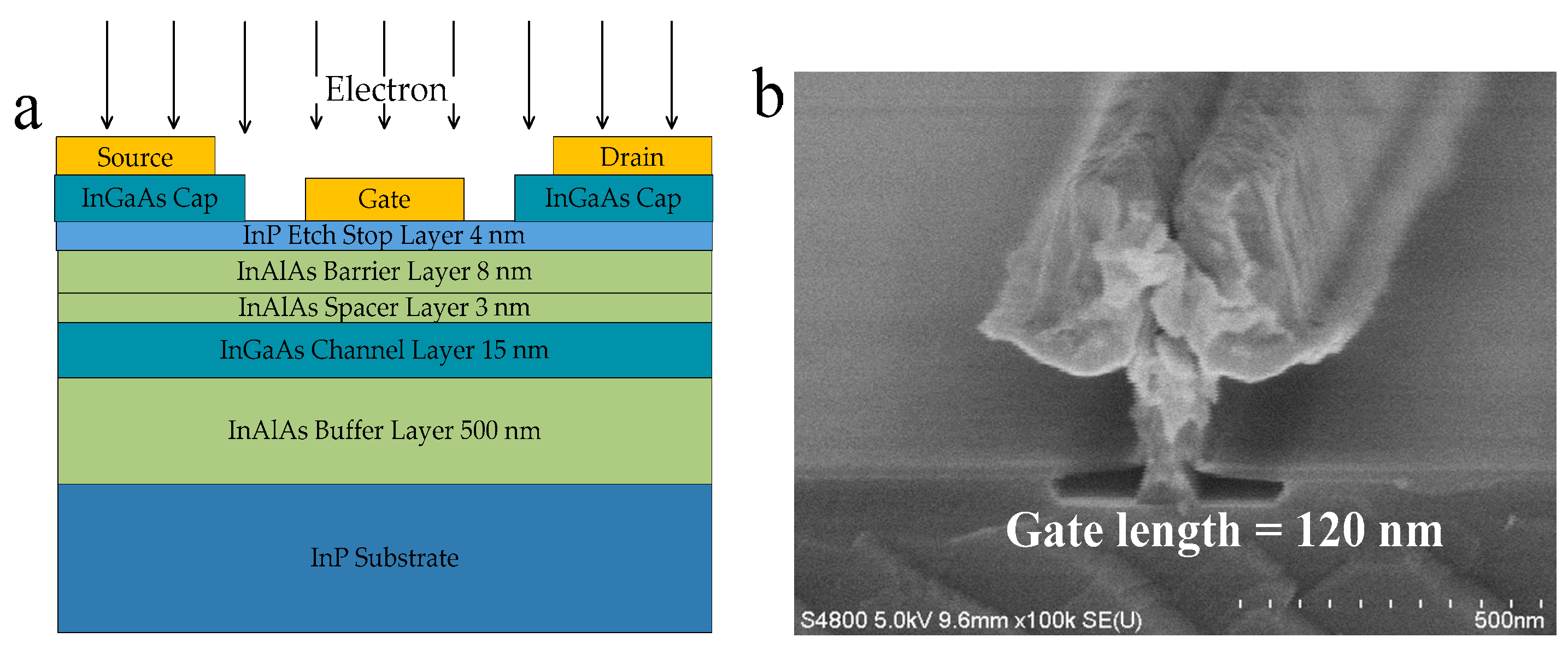
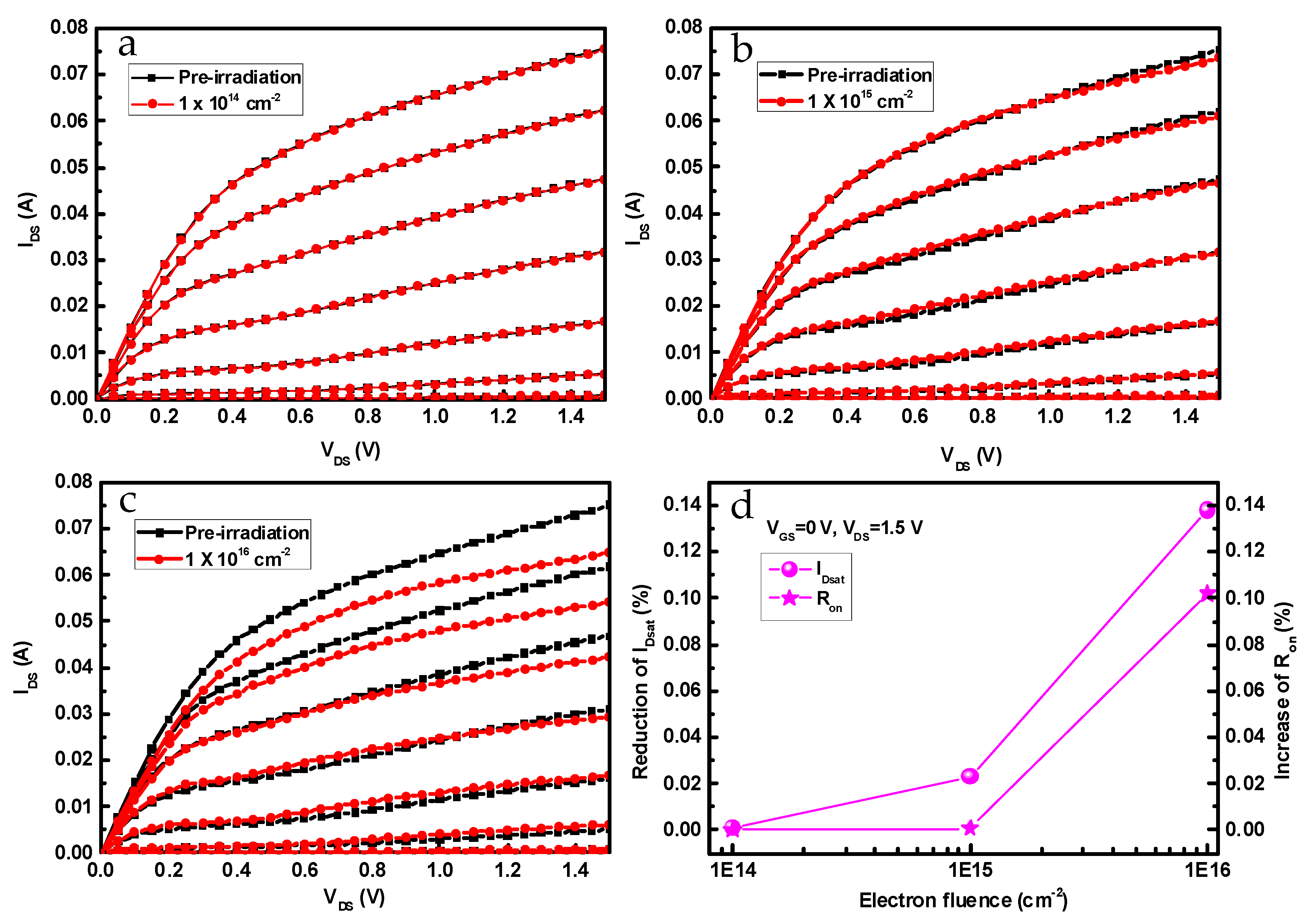
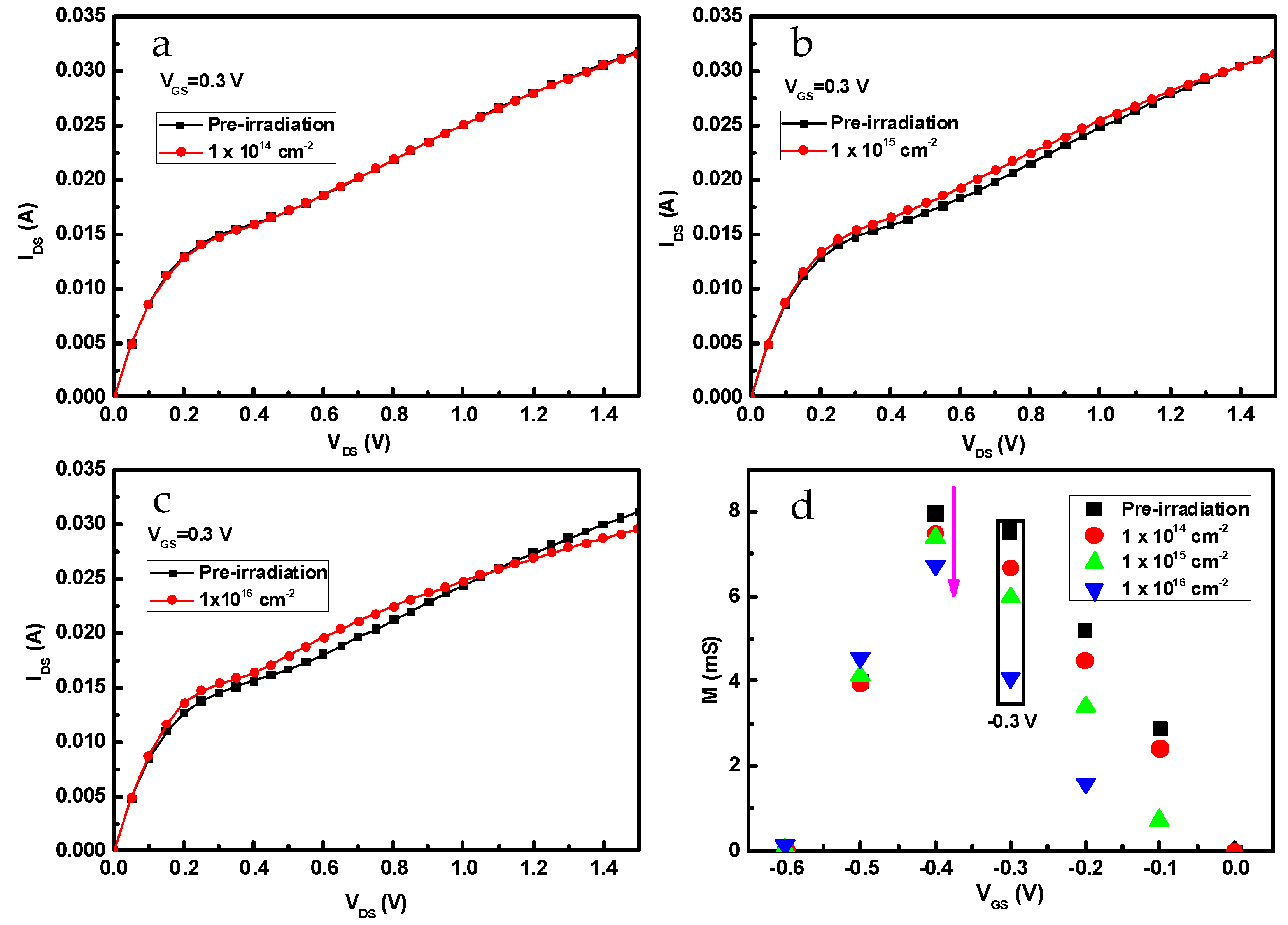
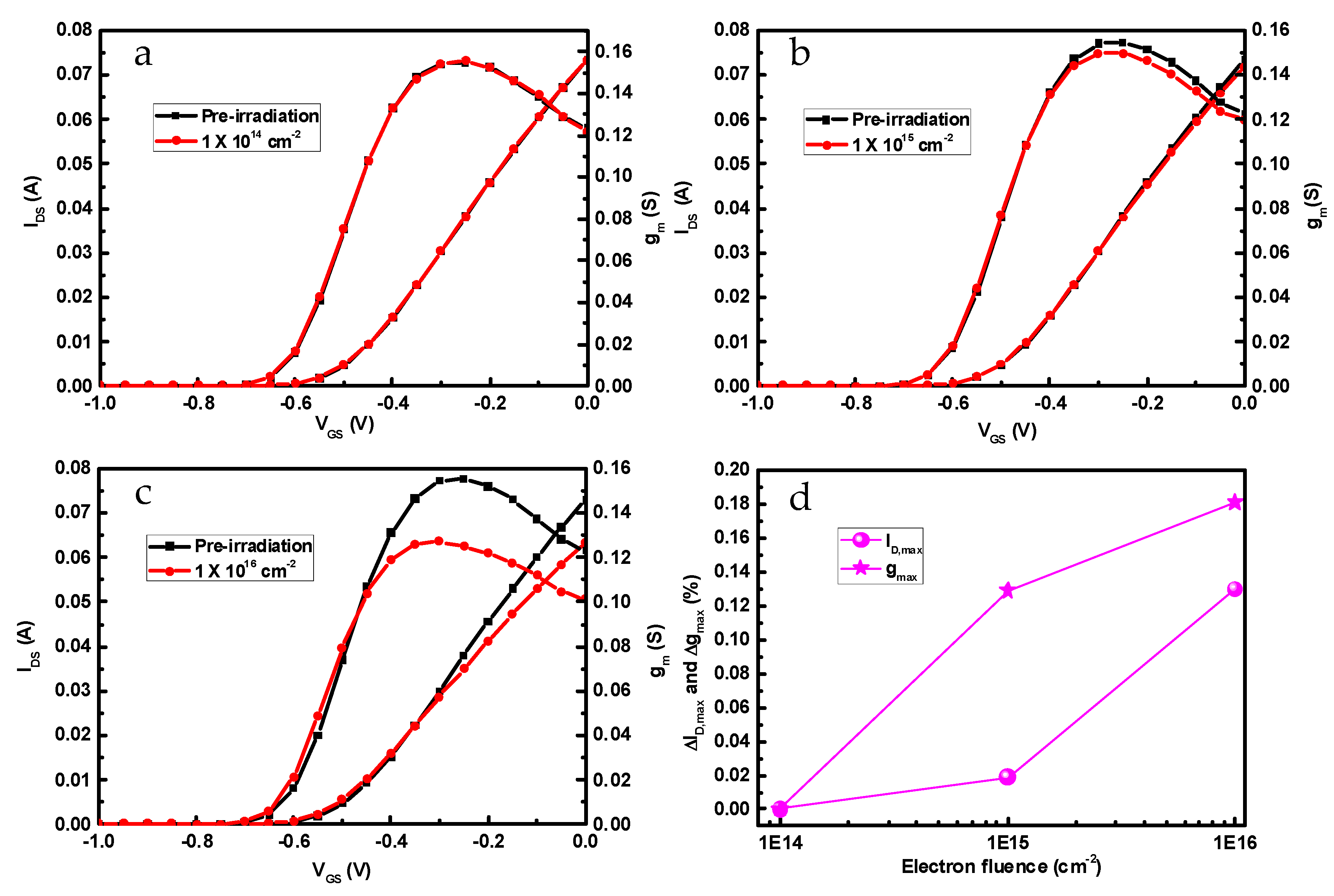
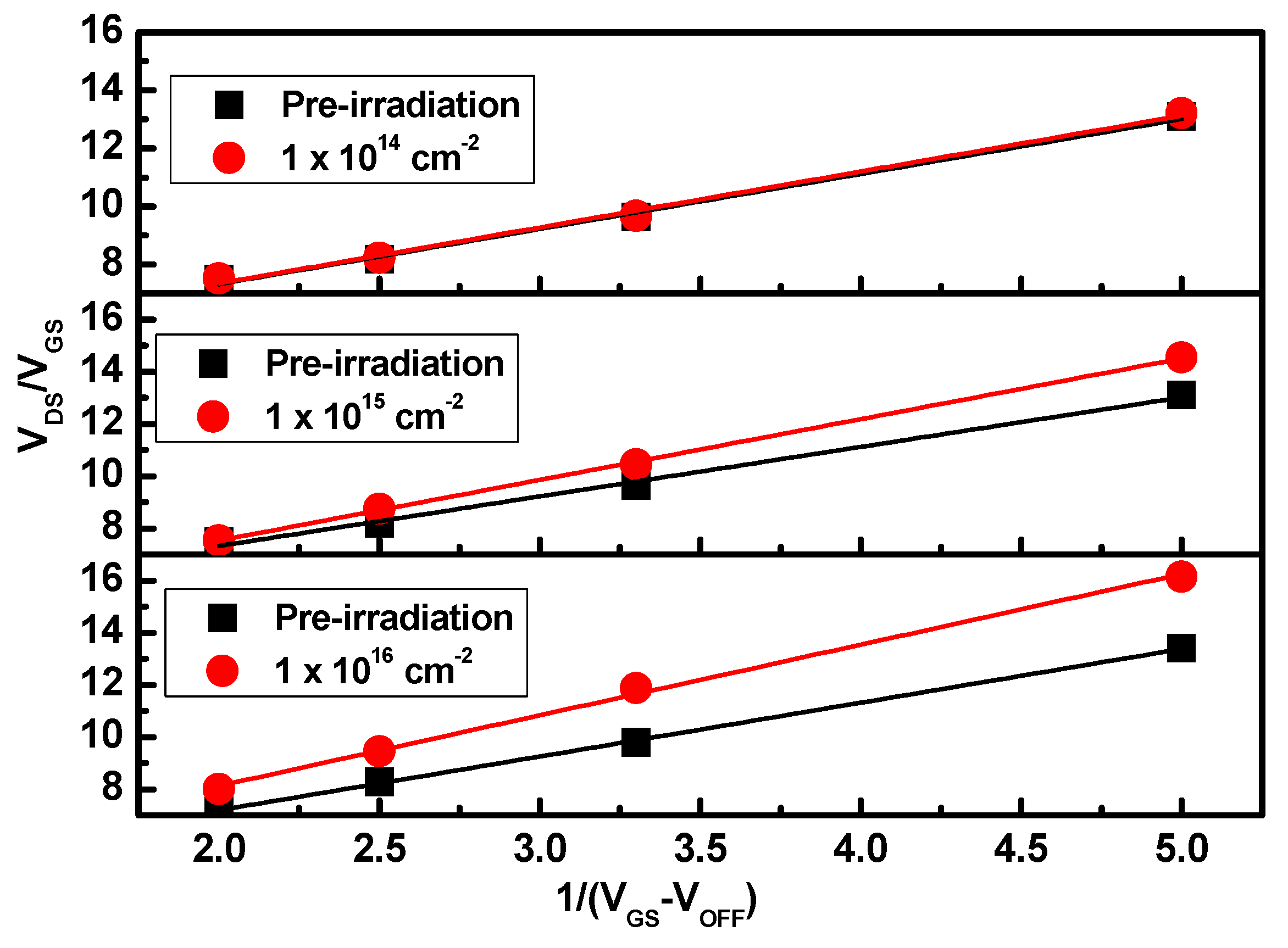
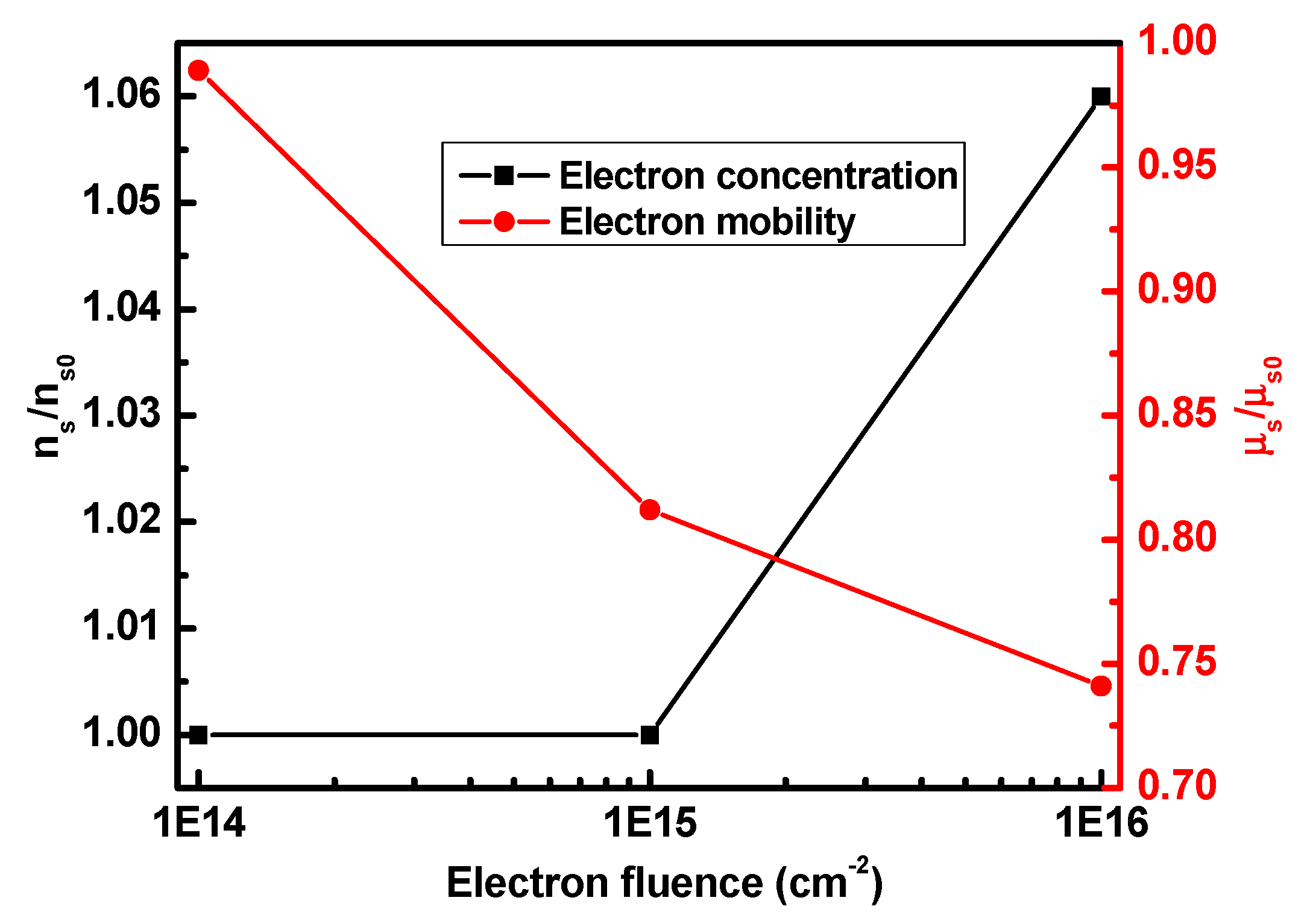
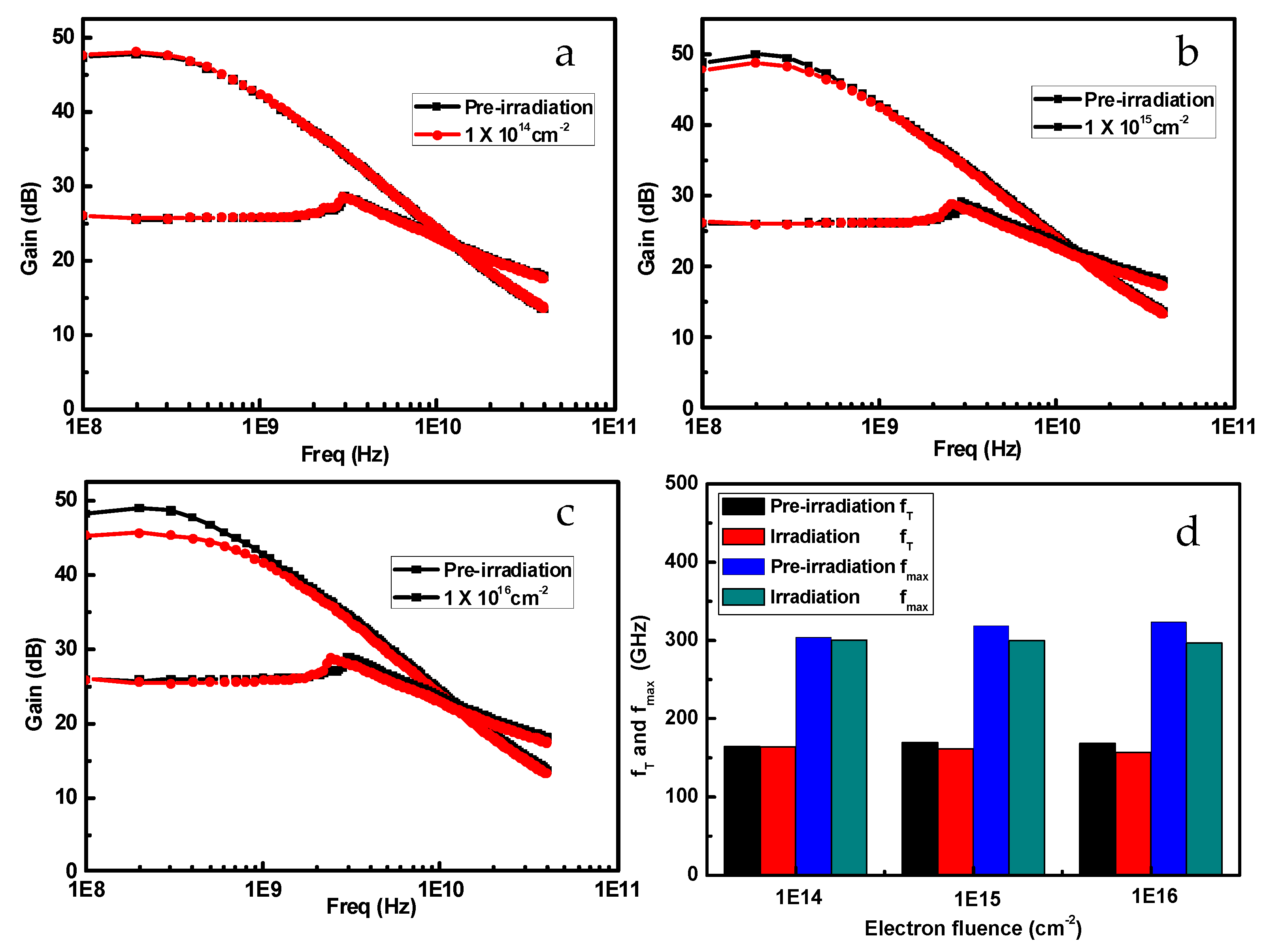

© 2019 by the authors. Licensee MDPI, Basel, Switzerland. This article is an open access article distributed under the terms and conditions of the Creative Commons Attribution (CC BY) license (http://creativecommons.org/licenses/by/4.0/).
Share and Cite
Sun, S.; Ding, P.; Jin, Z.; Zhong, Y.; Li, Y.; Wei, Z. Effect of Electron Irradiation Fluence on InP-Based High Electron Mobility Transistors. Nanomaterials 2019, 9, 967. https://doi.org/10.3390/nano9070967
Sun S, Ding P, Jin Z, Zhong Y, Li Y, Wei Z. Effect of Electron Irradiation Fluence on InP-Based High Electron Mobility Transistors. Nanomaterials. 2019; 9(7):967. https://doi.org/10.3390/nano9070967
Chicago/Turabian StyleSun, Shuxiang, Peng Ding, Zhi Jin, Yinghui Zhong, Yuxiao Li, and Zhichao Wei. 2019. "Effect of Electron Irradiation Fluence on InP-Based High Electron Mobility Transistors" Nanomaterials 9, no. 7: 967. https://doi.org/10.3390/nano9070967
APA StyleSun, S., Ding, P., Jin, Z., Zhong, Y., Li, Y., & Wei, Z. (2019). Effect of Electron Irradiation Fluence on InP-Based High Electron Mobility Transistors. Nanomaterials, 9(7), 967. https://doi.org/10.3390/nano9070967




